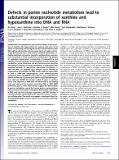Defects in purine nucleotide metabolism lead to substantial incorporation of xanthine and hypoxanthine into DNA and RNA
Author(s)
Pang, Bo; McFaline, Jose Luis; Burgis, Nicholas E.; Taghizadeh, Koli; Sullivan, Matthew R.; Elmquist, C. Eric; Cunningham, Richard P.; Dedon, Peter C.; Dong, Min, 1968-; ... Show more Show less
DownloadPang-2012-Defects in purine nucleotide metabolism lead to substantial.pdf (512.4Kb)
PUBLISHER_POLICY
Publisher Policy
Article is made available in accordance with the publisher's policy and may be subject to US copyright law. Please refer to the publisher's site for terms of use.
Terms of use
Metadata
Show full item recordAbstract
Deamination of nucleobases in DNA and RNA results in the formation of xanthine (X), hypoxanthine (I), oxanine, and uracil, all of which are miscoding and mutagenic in DNA and can interfere with RNA editing and function. Among many forms of nucleic acid damage, deamination arises from several unrelated mechanisms, including hydrolysis, nitrosative chemistry, and deaminase enzymes. Here we present a fourth mechanism contributing to the burden of nucleobase deamination: incorporation of hypoxanthine and xanthine into DNA and RNA caused by defects in purine nucleotide metabolism. Using Escherichia coli and Saccharomyces cerevisiae with defined mutations in purine metabolism in conjunction with analytical methods for quantifying deaminated nucleobases in DNA and RNA, we observed large increases (up to 600-fold) in hypoxanthine in both DNA and RNA in cells unable to convert IMP to XMP or AMP (IMP dehydrogenase, guaB; adenylosuccinate synthetase, purA, and ADE12), and unable to remove dITP/ITP and dXTP/XTP from the nucleotide pool (dITP/XTP pyrophosphohydrolase, rdgB and HAM1). Conversely, modest changes in xanthine levels were observed in RNA (but not DNA) from E. coli lacking purA and rdgB and the enzyme converting XMP to GMP (GMP synthetase, guaA). These observations suggest that disturbances in purine metabolism caused by known genetic polymorphisms could increase the burden of mutagenic deaminated nucleobases in DNA and interfere with gene expression and RNA function, a situation possibly exacerbated by the nitrosative stress of concurrent inflammation. The results also suggest a mechanistic basis for the pathophysiology of human inborn errors of purine nucleotide metabolism.
Date issued
2012-02Department
Massachusetts Institute of Technology. Center for Environmental Health Sciences; Massachusetts Institute of Technology. Department of Biological Engineering; Massachusetts Institute of Technology. Department of BiologyJournal
Proceedings of the National Academy of Sciences
Publisher
National Academy of Sciences
Citation
Pang, B. et al. “Defects in Purine Nucleotide Metabolism Lead to Substantial Incorporation of Xanthine and Hypoxanthine into DNA and RNA.” Proceedings of the National Academy of Sciences 109.7 (2012): 2319–2324. Copyright ©2012 by the National Academy of Sciences
Version: Final published version
ISSN
0027-8424
1091-6490